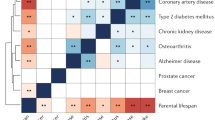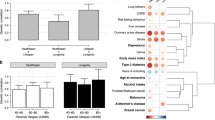Abstract
Glutathione is a ubiquitous antioxidant that protects cells against reactive oxygen species and other chemical stressors. Despite its functional importance, the impact of genetics on the glutathione system has yet to be fully appreciated. Here, we investigated the heritability of glutathione levels and redox status in a disease-relevant condition: advanced age. We assembled a panel of 18–21-month-old mice representing 19 inbred strains and quantified the levels of reduced and oxidized glutathione, and their sums and ratios, in liver, kidney, heart, pancreas, cerebral cortex, and striatum. Heritability values were calculated for each phenotype and the results varied by tissue of origin. Cardiac glutathione phenotypes exhibited the highest heritabilities (G2 = 0.44–0.67), while striatal glutathione was least heritable (G2 = 0.11–0.29). Statistical relationships between tissues were evaluated, and the emergence of significant correlations suggested that despite tissue-specific heritabilities, at least some shared regulatory mechanisms may exist. Overall, these data highlight another mechanism by which genetic background determines antioxidant protection and stress resistance.







Similar content being viewed by others
References
Altomare E, Vendemiale G, Albano O (1988) Hepatic glutathione content in patients with alcoholic and non-alcoholic liver diseases. Life Sci 43:991–998
Borroz KI, Ramsdell H, Eaton DL (1991) Mouse strain differences in glutathione S-transferase activity and aflatoxin B1 biotransformation. Toxicol Lett 58:97–105
Buhl R, Holroyd J, Holroyd KJ, Wells FB, Mastrangli A, Cantin A, Saltini C, Cantin AM, Crystal RG (1989) Systemic glutathione deficiency in symptom free HIV-seropositive individuals. Lancet 2:1294–1298
Chinta SJ, Shankar R, Butterfield DA, Andersen JK (2006) In vitro and in vivo neuroprotection by γ-glutamylcysteine ethyl ester against MPTP: Relevance to the role of glutathione in Parkinson’s disease. Neurosci Lett 402:137–141
Droge W (1993) Cysteine and glutathione deficiency in AIDS patients: a rationale for the treatment with N-acetyl-cysteine. Pharmacology 46:61–65. https://doi.org/10.1159/000139029
Egaas E, Falls J, Dauterman WC (1995) A study of gender, strain and age differences in mouse liver glutathione-S-transferase. Comp Biochem Physiol C 110:35–40
Falconer D, Mackay T (1996) Introduction to quantitative genetics, vol 4. Longman, Essex
Ferguson M, Rebrin I, Forster M, Sohal R (2008) Comparison of metabolic rate and oxidative stress between two different strains of mice with varying response to caloric restriction. Exp Gerontol 43:757–763
Festing M (1979) Notes on genetic analysis inbred strains in biomedical research
Forrester TE, Badaloo V, Bennett FI, Jackson AA (1990) Excessive excretion and decreased levels of blood glutathione in type II diabetes mellitus Eur. J Clin Nutr 44:846–850
Giblin FJ (2000) Glutathione: a vital lens antioxidant. J Ocul Pharmacol Ther 16:121–135. https://doi.org/10.1089/jop.2000.16.121
Gimelfarb A, Willis JH (1994) Linearity Versus nonlinearity of offspring-parent regression: an experimental study of Drosophila melanogaster. Genetics 138:343–352
Harding JJ (1970) Free and protein-bound glutathione in normal and cataractous human lenses. Biochem J 117:957–960
Julius M, Lang CA, Gleiberman L, Harburg E, DiFranceisco W, Schork A (1994) Glutathione and morbidity in a community-based sample of elderly. J Clin Epidemiol 47:1021–1026
Kalkan IH, Suher M (2013) The relationship between the level of glutathione, impairment of glucose metabolism and complications of diabetes mellitus Pakistan. J Med Sci 29:938–942
Lang CA, Mills B, Lang HL, Liu MC, Usui WM, Richie J Jr, Mastropaolo W, Murrell SA (2002) High blood glutathione levels accompany excellent physical and mental health in women ages 60 to 103 years. Clin Med 140:413–417
Li J, Wang H, Stoner GD, Bray TM (2002) Dietary supplementation with cysteine prodrugs selectively restores tissue glutathione levels and redox status in protein-malnourished mice. J Nutr Biochem 13:625–633
Maher P (2018) Potentiation of glutathione loss and nerve cell death by the transition metals iron and copper: implications for age-related neurodegenerative diseases. Free Radic Biol Med 115:92–104. https://doi.org/10.1016/j.freeradbiomed.2017.11.015
Meakin LB, Sugiyama T, Galea GL, Browne WJ, Lanyon LE, Price JS (2013) Male mice housed in groups engage in frequent fighting and show a lower response to additional bone loading than females or individually housed males that do not fight. Bone 54:113–117. https://doi.org/10.1016/j.bone.2013.01.029
Murakami K, Takahito K, Ohtsuka Y, Shimada M, Kawakami Y (1989) Impairment of glutathione metabolism in erythrocytes from patients with diabetes mellitus. Metabolism 38:753–758
Norris KM, Okie W, Kim WK, Adhikari R, Yoo S, King S, Pazdro R (2016a) A high-fat diet differentially regulates glutathione phenotypes in the obesity-prone mouse strains DBA/2J, C57BL/6J, and AKR/J. Nutr Res 36:1316–1324
Norris KM, Okie W, Yakaitis CL, Pazdro R (2016b) The anthocyanin cyanidin-3-O-β-glucoside modulates murine glutathione homeostasis in a manner dependent on genetic background. Redox Biol 9:254–263
Park HJ, Mah E, Bruno RS (2010) Validation of high-performance liquid chromatographyboron-doped diamond detection for assessing hepatic glutathione redox status. Anal Biochem 407:151–159
Petkov PM, Ding Y, Cassell MA, Zhang W, Wagner G, Sargent EE, Asquith S, Crew V, Johnson KA, Robinson P, Scott VE, Wiles MV (2004) An efficient SNP system for mouse genome scanning and elucidating strain relationships. Genome Res 14:1806–1811
Prabhakar R, Vreven T, Morokuma K, Musaev DG (2005) Elucidation of the mechanism of selenoprotein glutathione peroxidase (GPx)-catalyzed hydrogen peroxide reduction by two glutathione molecules: a density functional study. Biochemistry 44:11864–11871
Rebrin I, Sohal RS (2008) Pro-oxidant shift in glutathione redox state during aging. Adv Drug Deliv Rev 60:1545–1552
Rebrin I, Kamzalow S, Sohal RS (2003) Effects of age and caloric restriction on glutathione redox state in mice. Free Radic Biol Med 35:626–635
Rebrin I, Forster M, Sohal RS (2007) Effects of age and caloric intake on glutathione redox state in different brain regions of C57BL/6 and DBA/2 mice. Brain Res 1127:10–18
Rebrin I, Forster M, Sohal RS (2011) Association between life-span extension by caloric restriction and thiol redox state in two different strains of mice. Free Radic Biol Med 51:225–233
Townsend DM, Tew KD, Tapiero H (2003) The importance of glutathione in human disease. Biomed Pharmacother 57:145–155
Tsuchiya M, Ji C, Kosyk O, Shymonyak S, Melnyk S, Kono H, Tryndyak V, Muskhelishvili L, Pogribny IP, Kaplowitz N, Rusyn I (2012) Interstrain differences in liver injury and one-carbon metabolism in alcohol-fed mice. Hepatology 56:130–139
van ‘t Erve TJ, Wagner BA, Ryckman KK, Raife TJ, Buettner GR (2013) The concentration of glutathione in human erythrocytes is a heritable trait. Free Radic Biol Med 65:742–749. https://doi.org/10.1016/j.freeradbiomed.2013.08.002
Yuan L, Kaplowitz N (2009) Glutathione in liver diseases and hepatotoxicity. Mol Aspects Med 30:29–41. https://doi.org/10.1016/j.mam.2008.08.003
Yuan R, Tsaih S, Petkova SB, Marin de Evsikova C, Xing S, Marion MA, Bogue MA, Mills KD, Peters LL, Bult CJ, Rosen CJ, Sundberg JP, Harrison DE, Churchill GA, Paigen B (2009) Aging in inbred strains of mice: study design and interim report on median lifespans and circulating IGF1 levels. Aging Cell 8:277–287
Yuan R, Flukery K, Meng Q, Astle MC, Harrson DE (2013) Genetic regulation of life span, metabolism, and body weight in Pohn, a new wild-derived mouse strain. J Gerontol A 68:27–35
Zhou Y, Harrison DE, Love-Myers K, Chen Y, Grider A, Wickwire K, Burgess JR, Stochelski MA, Pazdro R (2014) Genetic analysis of tissue glutathione concentrations and redox balance. Free Radic Biol Med 71:157–164
Acknowledgements
The authors gratefully acknowledge Funing Chen for his assistance with this project. This work was supported by the University of Georgia Office of the Vice President for Research; the College of Family and Consumer Sciences; and National Institute of Food and Agriculture Hatch Grant GEO00735.
Author information
Authors and Affiliations
Corresponding author
Ethics declarations
Conflict of interest
The authors declare that they have no conflict of interest.
Electronic supplementary material
Below is the link to the electronic supplementary material.
Rights and permissions
About this article
Cite this article
Gould, R.L., Zhou, Y., Yakaitis, C.L. et al. Heritability of the aged glutathione phenotype is dependent on tissue of origin. Mamm Genome 29, 619–631 (2018). https://doi.org/10.1007/s00335-018-9759-2
Received:
Accepted:
Published:
Issue Date:
DOI: https://doi.org/10.1007/s00335-018-9759-2




